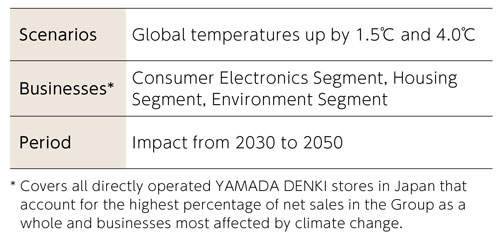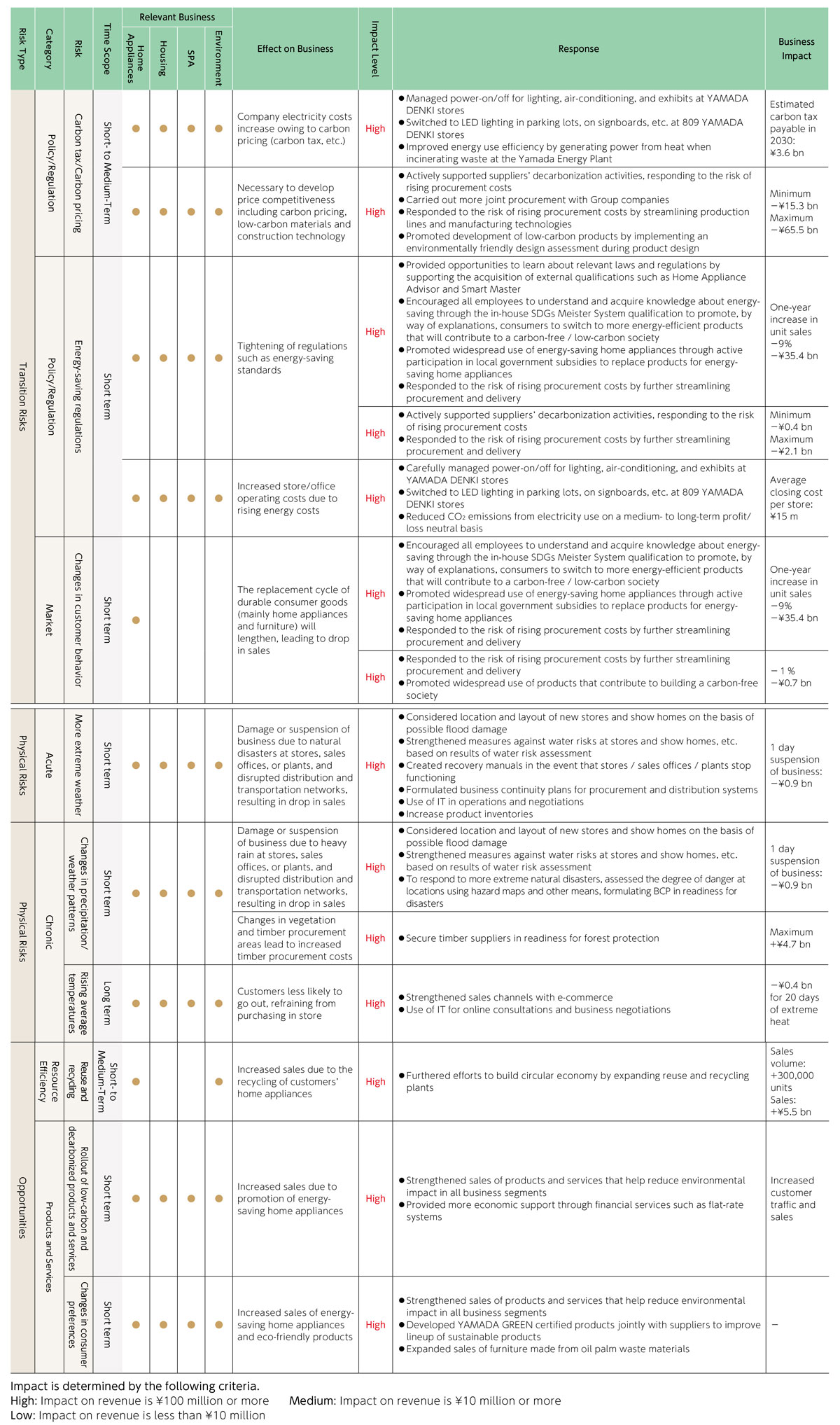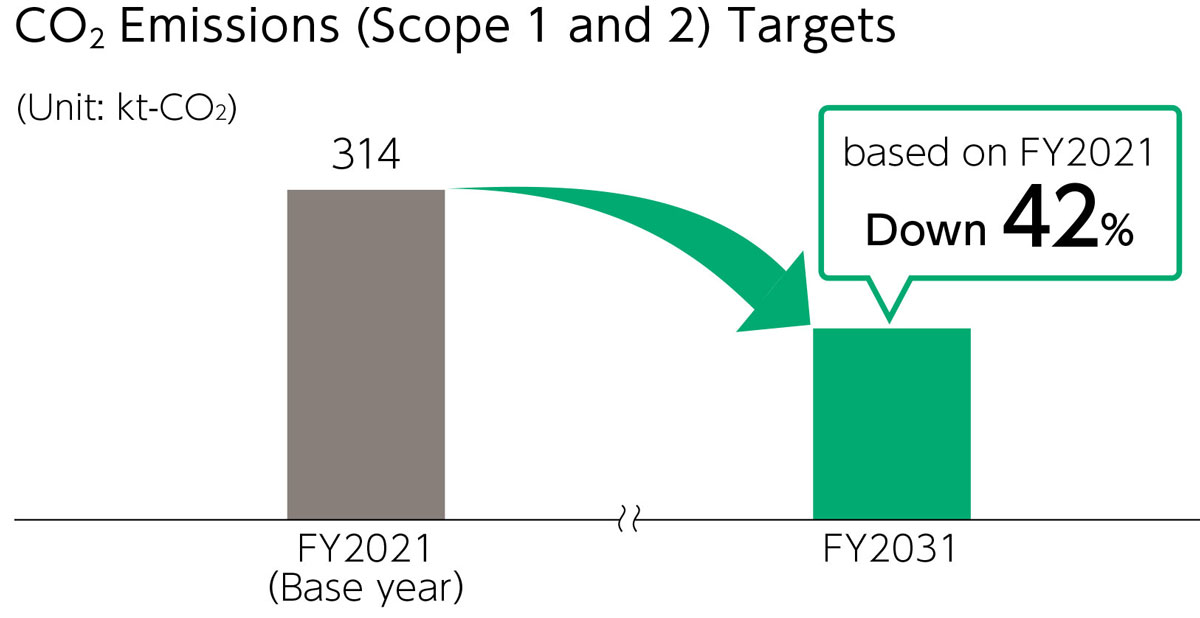Based on its “Total-Living” concept, the YAMADA HOLDINGS Group handles a wide variety of home appliances, housing equipment, furniture and interior goods that support customers’ lifestyles. These products are manufactured and processed not only in Japan but also in other parts of the world, using various resources from each region. For this reason, we believe that tackling climate change and preserving the natural environment are important themes for the sustainable growth of the Group. For disclosure based on the Task Force on Climate-related Financial Disclosures (TCFD), the Group is looking at the current state of the whole Group, developing a governance system, and examining strategies, risk management, metrics and targets. Going forward, we will continue to appropriately manage the risks associated with climate change, and view various changes toward a carbon-free world as business opportunities that will lead to sustainable growth.
At YAMADA HOLDINGS, the Board of Directors discusses important management and business strategies, makes policy decisions, and supervises the ESG & Sustainability Promotion Committee. The ESG & Sustainability Promotion Committee makes decisions on important matters, and subcommittees thereunder discuss the details of individual activities and confirm the progress of activities and targets. In addition, the ESG & Sustainability Promotion Committee examines important issues, such as climate change risks and opportunities identified from scenario analysis, and regularly reports to the Board of Directors on the status of addressing these risks, so that the Board of Directors can fully exercise its supervisory function.
Based on the TCFD recommendations, the Group has established the target businesses, timelines, and scenarios to analyze and assess the climate change risks and opportunities.

This scenario sees regulations and policies for decarbonization tightened and measures against climate change progressing with the temperature rise from pre-industrial levels at around 1.5°C to 2.0°C. As customers’ preferences for products and services change and companies are more strongly required to tackle climate change, it is likely that transition risks, including less customers and greater reputational risk, will increase if the companies fail to do so. Conversely, it is assumed that the physical risks would be relatively low compared to the 4.0°C scenario, with for example, more extreme and prevalent disasters caused by climate change being suppressed to some extent. (Reference: The International Energy Agency’s Net Zero Emissions by 2050 Scenario)
A scenario in which sufficient measures against climate change are not taken and the temperature rises around 4°C from pre-industrial levels. It is assumed that physical risks would increase, with for example, more extreme natural disasters, rising sea levels, and an increase in abnormal weather events. As a result, it is thought that climate change-resilient products and services in terms of good BCP will become more competitive. Conversely, it is assumed that transition risks would be low, with for example, the government’s lack of tighter regulations. (Reference: The Intergovernmental Panel on Climate Change’s RCP8.5 Scenario)

We consider climate-related risks as one of the most significant risks impacting our Group’s business and integrate them into our Companywide risk management process. For long-term risk and opportunity assessments, approximately every three years, the Sustainability Promotion Department conducts a detailed analysis of “external environmental changes” such as political, economic, social, and competitive changes due to the transition to a decarbonized society and “physical changes” due to the progression of global warming. We analyze the probability that various changes may occur and the financial impact if these risks materialize to identify risks and opportunities. For risks and opportunities with a financial impact on revenue exceeding ¥100 million, they are reviewed by the Risk Management Committee and evaluated as significant risks and opportunities for the Group. Based on the risks and opportunities assessed there, we revise our environmental policy and reflect these in identifying and evaluating key issues, major initiatives, and goal setting.
For short- to medium-term risk and opportunity identification and evaluation, we gather information on “external environmental changes” and “physical changes” throughout the fiscal year. In light of the response status of each department and Group company, we analyze the validity and achievement of targets twice a year (once every six months) and reevaluate significance. If significant revisions arise, they are discussed, identified, and evaluated at the ESG & Sustainability Promotion Committee, which meets quarterly, or four times per year. The discussions held by the ESG & Sustainability Promotion Committee are reported to the Board of Directors once a year.
The Group has set a goal of reducing CO2 emissions in Scope 1 and 2 by 42% by fiscal 2031, compared to fiscal 2021.
